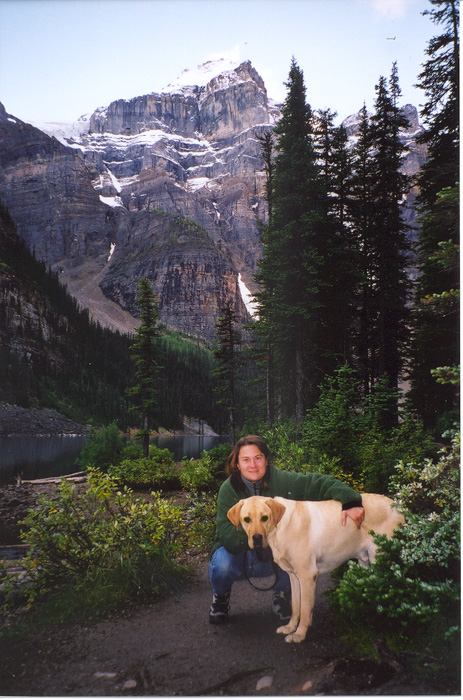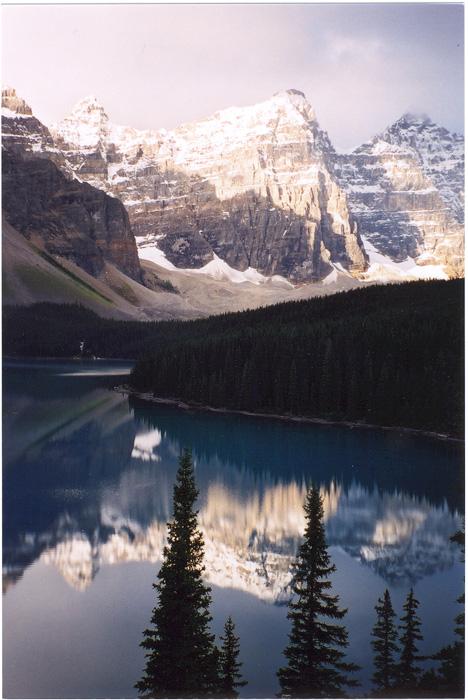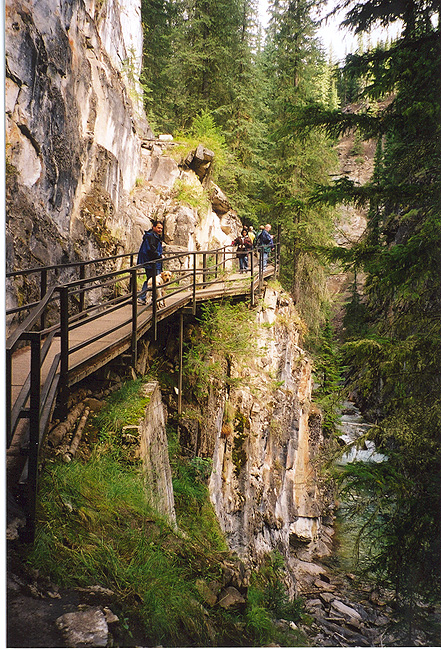| NOgo Tour '00-'01 | Home | Route | Dispatches | Background | Links |
|
| ||
| re: Mountains and Apples | date: Sept. 6, 2000 | location: Alberta, Canada |
|
The words "around the world backpacking trip" bring to mind a dazzling flurry of images -- steamy jungles, crowded train platforms, exotic alphabets, strange meat. I guess it's appropriate, then, that our first night on this grand adventure was spent in the Tiki Village Inn - a Canadian hotel with a Polynesian name, Japanese decor, French facial soap, and a Chinese restaurant serving "full American breakfast". Throw some Phad Thai and a serious bout of diarrhea into this ethnic jamboree and we could just skip the rest of our trip. The Tiki Village Inn is located in British Columbia at the north end of the Okanogan Valley, a 100-mile Eden of apples, mountain lakes, vineyards, and ski areas. We had left Seattle at 9:30 am, a little dazed and without the weighty introspection that such an occasion deserved. Within an hour we had crossed Snoqualmie Pass and dropped into the desert climate of central Washington. We followed the Columbia river upstream, then turned straight north towards the Canadian border driving through the sparsely-populated land of orchards and taco stands serving the migrant workers that work there. We crossed the border at Osoyoos, BC and entered "Canada's only desert". (It looked more like a Napa valley of apples and pears than a harsh desert; but, hey, everything in Canada is a little more civil.) The road wound north, carved into mountains that dropped into huge, long lakes. Let's start a list - "Places We Need to Return To" - and put the Okanogon right at the top. I must say it felt strange walking into that hotel, the first of 365 or so nights we'd spend in strange beds before going home. We were both a bit quiet as we surveyed the room. I decided not to voice my thought that months down the road when we were stuck in some cockroach-infested ghetto in Saigon or Bangkok with a rusty bucket for a toilet we would pine wistfully for the Tiki Village Inn in Vernon, BC. Fact is, all we needed was a place to sleep before heading on to our first big destination, Banff National Park. We woke up early the next morning and headed north. Soon we turned east onto Highway 1, the Trans-Canada Highway, a road we would follow for the next 1,000 miles, give or take. Highway 1 is Canada's great national road. It travels all the way from Vancouver Island on the west to St. Johns Newfoundland in the east. The highway cuts through countless mountain ranges, across fierce rivers and endless plains of wheat. You are probably picturing six lanes glistening concrete - a smooth ribbon of highway laid from coast to coast. You'd be wrong. Much of the Trans-Canada highway is a bumpy 2-lane country road, dotted yellow line and all. I'm not saying that's bad - after all, the ain't the U.S. of A. Within minutes of joining the highway it was clear we were in for a beautiful drive. Over the next few hours, we were to drive through not one, not two, not three, but four national parks. And came within spittin' distance of two more! First came Mount Revelstoke NP, then Glacier NP (not to be confused with the US park of the same name in Montana). Then a gorgeous drive through a broad valley that wasn't officially national park before driving across the spine of the Rockies in Yoho NP and Banff NP. While Banff National Park gets most of attention, it's actually just one of four adjoining national parks, all magnificent. To the north is Jasper, then comes Banff, Yoho, and finally Kooteney to the south. Most of this territory is empty. No roads, no towns, just towering rock faces and alpine forests. Because our time here was limited, we decided to focus on the most accessible area - the 60 miles between the towns of Lake Louise and Banff. We reached the Lake Louise by 2:00, checked into a hotel and set out to explore. First we took Loki on a walk along the river. To our left and across the valley was the Lake Louise ski area, which claims to be the largest in Canada (is it really bigger than Whistler/Blackcomb?). We walked through the small town of Lake Louise. . . really just a liquor store, a small grocery, a deli, and visitor information center. Then we drove 5 km up the other side of the valley to the lake itself. Lake Louise is located about 1000 feet above the valley floor. It's a brilliant lime green color, set in an enormous bowl of mountains. At the far end of the lake an immense peak rises, and you can literally see the cross-sections of the glaciers where they've broken off as they cascade over the cliffs of the mountain. It's an amazing site and much different than - say - Mt. Rainier where the glaciers seem to have conquered the mountain, rather than the other way around. The next morning we rose early and drove up to Moraine lake before sunrise. Moraine lake is smaller than Lake Louise but equally spectacular. It's surrounded by 12 stony peaks, and we watched the sun rise on all of them as we hiked around the lake. Then we drove south, towards the town of Banff. We stopped for a short (1 mile) hike in the Johnston Canyon. It's a fun little hike along paved walkways that they've set above a raging stream, deep down in a small narrow canyon. Finally, we took a quick stroll through the town of Banff and the Banff Springs Hotel. The town is nice enough, but pretty much what you'd expect from a resort town. Gear shops, t-shirt shops, and hotels. It's a nice looking town, though, and you can't beat the setting. The Banff Springs Hotel was neat. It's not often that something you've seen in postcards your whole life lives up to your expectations, but it was a truly impressive building. Unfortunately we had miles to cover before we slept, so it was time to hit the road. We would have liked to see the Jasper area, and a hike in the backcountry would have been nice, but we'll have to save those for another day. Now East to the land of prairies!
| ||
| More Dispatches |
| Copyright © 2001 Geoffrey Nelson | Send mail to: Geoff | Sarah |


